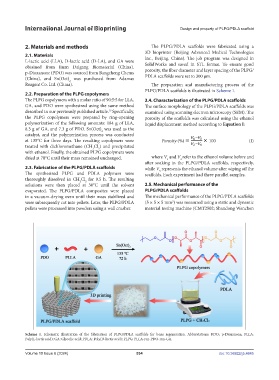Page 542 - IJB-10-6
P. 542
International Journal of Bioprinting Design and property of PLPG/PDLA scaffold
2. Materials and methods The PLPG/PDLA scaffolds were fabricated using a
3D bioprinter (Beijing Advanced Medical Technologies
2.1. Materials Inc., Beijing, China). The job program was designed in
L-lactic acid (LLA), D-lactic acid (D-LA), and GA were
obtained from Jinan Daigang Biomaterial (China). SolidWorks and saved in STL format. To ensure good
p-Dioxanone (PDO) was sourced from Bangcheng Chems porosity, the fiber diameter and layer spacing of the PLPG/
(China), and Sn(Oct) was purchased from Adamas PDLA scaffolds were set to 300 µm.
2
Reagent Co. Ltd. (China). The preparation and manufacturing process of the
PLPG/PDLA scaffolds is illustrated in Scheme 1.
2.2. Preparation of the PLPG copolymers
The PLPG copolymers with a molar ratio of 90:5:5 for LLA, 2.4. Characterization of the PLPG/PDLA scaffolds
GA, and PDO were synthesized using the same method The surface morphology of the PLPG/PDLA scaffolds was
described in our previously published article. Specifically, examined using scanning electron microscopy (SEM). The
29
the PLPG copolymers were prepared by ring-opening porosity of the scaffolds was calculated using the ethanol
polymerization of the following amounts: 184 g of LLA, liquid displacement method according to Equation I:
8.3 g of GA, and 7.3 g of PDO. Sn(Oct) was used as the
2
catalyst, and the polymerization process was conducted
at 135°C for three days. The resulting copolymers were Porosity (%) 100 (I)
treated with dichloromethane (CH Cl ) and precipitated
2
2
with ethanol. Finally, the obtained PLPG copolymers were
dried at 70°C until their mass remained unchanged. where V and V refer to the ethanol volume before and
1
2
after soaking in the PLPG/PDLA scaffolds, respectively,
2.3. Fabrication of the PLPG/PDLA scaffolds while V represents the ethanol volume after wiping off the
3
The synthesized PLPG and PDLA polymers were scaffolds. Each experiment had three parallel samples.
thoroughly dissolved in CH Cl for 0.5 h. The resulting
2
2
solutions were then placed at 30°C until the solvent 2.5. Mechanical performance of the
evaporated. The PLPG/PDLA composites were placed PLPG/PDLA scaffolds
in a vacuum-drying oven until their mass stabilized and The mechanical performance of the PLPG/PDLA scaffolds
were subsequently cut into pellets. Later, the PLPG/PDLA (5 × 5 × 5 mm ) was measured using a static and dynamic
3
pellets were processed into powders using a wall crusher. material testing machine (CMT2502; Shandong Wanchen
Scheme 1. Schematic illustration of the fabrication of PLPG/PDLA scaffolds for bone regeneration. Abbreviations: PDO: p-Dioxanone; PLLA:
Poly(L-lactic acid); GA: Glycolic acid; PDLA: Poly(D-lactic acid); PLPG: PLLA-ran-PDO-ran-GA.
Volume 10 Issue 6 (2024) 534 doi: 10.36922/ijb.4645

